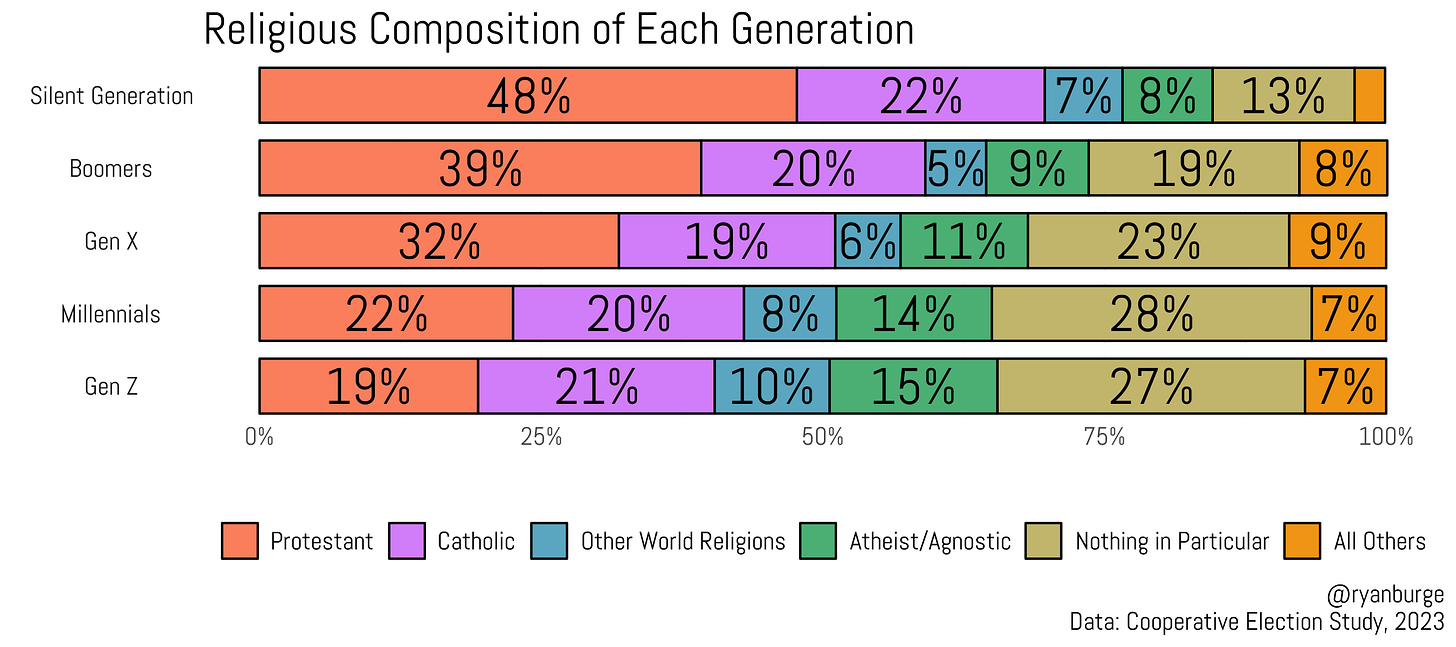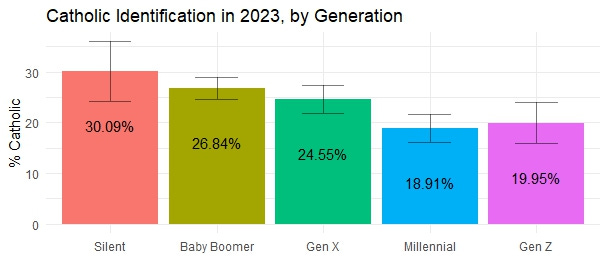About that Controversial Gen Z Finding...
Further evidence confirming that Catholic identification has increased among Gen Z shifts the burden of proof to the skeptics
Sometimes overkill is necessary. Particularly when our first reaction to a finding is that it is suspicious, highly tentative, and leaves us feeling uncertain, lacking confidence in the steps we took to arrive at a conclusion. In such cases, we must look for more and more confirmation of our original finding before we can believe our lying eyes.
Such is the case with a controversial, discussion-provoking finding uncovered by Professor Ryan Burge last year showing that the percentage of Gen Z identifying as Catholic had jumped seven percentage points between 2021 and 2023. Like Professor Burge, many readers didn’t, couldn’t believe their eyes. In what had been a context of ever-creeping secularization approaching what felt like religion’s inevitable downward spiral, paired with the magnitude of the jump in identification recorded in that survey, it seemed too good to be true.
The supposedly controversial finding that kicked off the firestorm.
But hope springs eternal for Christians. Evidence out of Europe seemed to corroborate the conclusion that something was stirring among Gen Z. A poll conducted by YouGov for the Bible Society in Britain showed smaller-in-overall-size but equal-in-magnitude increases in church attendance among Gen Z youth in the United Kingdom, while reports from dioceses across England indicate significant upticks in catechumens and candidates joining the Church.
Reports out of France showed a 45% increase between 2024 and 2025 in adult (largely Gen Z) baptisms—itself building on a ten-year upward trend from the low of 3,900 in 2015 to 10,391 in 2025 (that’s 160% for those counting). These trends have been followed on by a year of record-breaking participation in this year’s Chartres pilgrimage (again, a largely Gen Z event, where the average age of participants this year was 20). And let’s not forget that similar news is emerging out of Belgium and Austria, too.
Following up on Professor Burge’s finding in the United States, I took a look at three surveys in two separate posts to see if the original controversial finding could be seen in other sources. In both, I found that a jump in Catholic identification similar to the one in Professor Burge’s post could indeed be seen.
Not trusting my lying eyes, I couldn’t help but look at another poll conducted by the Public Religion Research Institute conducted in 2023 the moment I came across it. Namely, I looked at the PRRI’s “Gen Z Survey.” The fact that the survey included nearly six thousand respondents means that the number of respondents aged 18-26 (Gen Z) was large enough to produce estimates of religious identification that we could be more confident in relative to the standard sample size of most surveys (~1000 respondents).
To the findings: the estimates of 20-21% among Gen Z in those earlier surveys suggesting a big bump in Catholic identification do not appear out of line. In this survey, we see that just under 20% of Gen Z respondents identified as Catholic. With this being the fourth survey confirming the original finding uncovered by Professor Burge, we really have to reckon with the possibility that there has been a genuine uptick in Catholic identification among the youth.
Author’s analysis of PRRI’s 2023 “Gen Z Survey” (with 95% confidence intervals).
Also interesting is the fact that this estimate slightly exceeded the percentage of Millennials (18.91%) identifying as Catholic. On its own, this isn’t enough to suggest a revival is underway, with Gen Z reversing the trend towards secularization that had intensified as Millennials came of age—not least because the two point estimates are not significantly from one another, statistically speaking. Perhaps the jump in Catholic identification is but a reversion of those raised in the faith who had fallen away—perhaps, though it is yet another datum pointing in the direction pointing towards revival.
One additional piece of evidence, however, does nudge us in that direction. When we look at the share of Catholics in each generation reporting that they attend Mass at least once per month, we see that there has been an uptick among Gen Z—putting them above Millennials and Gen X. Again, the variation we observe within each generation is such that these differences are not statistically significant at the conventional threshold, but it’s much closer than what we see when looking at Catholic identification.
Author’s analysis of PRRI’s 2023 “Gen Z Survey” (with 95% confidence intervals).
To recap: it’s getting harder to justify the skepticism some proponents of the secularization thesis continue to cling to. After seeing confirmatory evidence of a rather large bump in Catholic identification among Gen Z for a fourth time, the burden of proof has to shift to the skeptics. The fact that Gen Z is at least as likely, though probably more so, likely to identify as Catholic relative to Millennials—paired with the fact that they are starting to pull away in terms of their attendance at Mass—only points further towards the conclusion that the shift among Gen Z is real.





Important observations Christopher. It would be interesting to know to which version of Catholicism are the Gen Zers migrating -- the conservative/orthodox or progressive/permissive version. Most of the decline in Christianity is among the progressive/permissive denominations or at least such churches in each denomination.
The renowned sociologist Dr. Peter Berger reversed his thinking about the secularization theory as he so declared here: https://www.youtube.com/watch?v=bv3aLp27sO4. The secularization theory postulates that the more modern the world becomes religion will inevitably decline. Of course that is nonsense as Berger later proclaimed before is death.
The secular only has influence on religion when religion itself invites it into its sanctuaries. Those religions that remain strict, demanding and conservative/orthodox are not negatively impacted by the secular. Those that are negatively impacted are those that have become permissive, accommodating and progressive, adopting societal trends into their religions which inevitably results in numerical decline. There is little need to participate in religions that reflect same trends pervasive throughout society.
I suspect then, that Gen Zers are more attracted to the version of Catholicism that seeks to follow pre-Vatican II traditions. Those are the diocese that are growing the most within Catholicism.